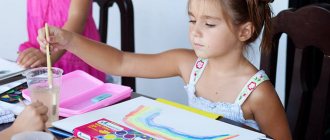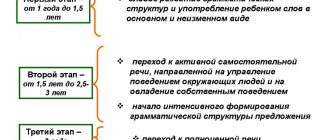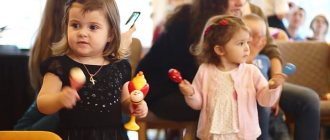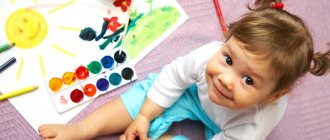10/22/2018 Yulia Shevchenko
General Director of the Perm Center for the Development of Giftedness Yulia Shevchenko took part in a discussion about the engineering thinking of preschoolers at the Leaders of Change forum and spoke about her impressions. We publish her opinion.
— The topic of the discussion in which I was invited to participate was designated “Engineering thinking of preschoolers.” True, there was a subtitle specifying that the conversation should turn towards the developmental effect of robotics and other types of technical activities available to preschoolers, but somehow it immediately focused on an attempt to separate a whole “nest” of concepts, to identify their boundaries, place and right to exist. This is probably correct: it is difficult to talk about the development of something if you are not sure that it exists or do not understand what the essence of this phenomenon is. Another thing is that meaning and essence are not the easiest subject for “podium” discussions, as they are in forum formats.
Engineering thinking - a process or a property?
Let's start with the main question for discussion about the legitimacy of distinguishing and the essence of engineering thinking. In general, thinking allows us to reflect patterns and cause-and-effect relationships. At the same time, two options are not distinguished in verbal form: thinking as a process of reflecting such patterns and thinking as a property that allows a person to reflect such patterns.
Therefore, a few clarifications. Mental processes are the basis of mental activity. Or, one might say, mental activity (the work of the psyche) is realized in mental processes. Mental properties are some stable characteristics by which people can differ from each other. They represent stable characteristics that determine the effectiveness of a particular process in a particular person. The difference between mental processes and properties (and there are also mental states, but we won’t talk about them now) is not always easy to grasp. Understanding is usually facilitated by the use of physiological analogies. Physiology also has processes and their individual characteristics (and states, but we won’t talk about them). Let's take digestion. In general, this is a certain process that is characteristic of everyone, for simplicity, let’s say, people. But if someone says that due to “weak digestion” he is forced to give up a certain product, he is talking about a property that distinguishes him from other people.
Engineering thinking for everyone?
One of the questions that was repeated several times yesterday was whether engineering thinking is inherent in everyone, or is it a gift of a select few (sounded in the context of “is it necessary to work with everyone?”). Here I will use an analogy again. Does everyone have logical thinking? If we consider it as a procedural characteristic, then the answer is clear: of course. Thinking is logical by nature, this is its integral characteristic, but when we say about someone “he has wonderful logical thinking!”, We are pointing to special properties, some property that distinguishes one person from others. Therefore, in practice the concepts of “developed logical thinking”, “weak logical thinking”, etc. are used.
The difficulty with engineering thinking is that the legitimacy of its identification is not so obvious, although this concept has been introduced both into the scientific field and into applied contexts, and of course, for the first time it was not heard in “recent documents from the Department of Education,” as was mentioned yesterday. The need for it arose when it was not possible to explain by the work of other aspects of thinking the possibility of solving problems of a certain type - engineering problems. Let's take a trivial one: you need to pull out a small ball that has rolled into a very narrow gap between the sofa and the floor. If we have an object that looks like a stick, this sets one level of the problem. What if there is no mop, but only sheets of paper, or only a plastic bottle, or, say, only a banana? Relying only on logical, mathematical, or artistic thinking, it is impossible to solve such a problem. And, if we try to imagine, visualize what is happening in our heads when we are looking for a way to cope with this difficulty, most likely we will see something special, similar to diagrams from physics textbooks. Therefore, I personally support the opinion that specific engineering thinking does exist. Different researchers describe the characteristics unique to engineering thinking in different ways. I personally really liked the statement from some relatively recent popular science article that engineering thinking allows you to see structures and act under constraints. I think the article stated that it was from the book Think Like an Engineer. The book doesn't have very good reviews on Ozone, but it looks like I wanted to form my own opinion.
Exercises and games to develop thinking in preschool children
In order for thinking to actively develop, you need to constantly work with your child. To help parents and educators there will be didactic, educational and entertainment classes, excursions, meetings with specialists, as well as regular games with children.
Development of imaginative thinking in a preschooler
To develop imaginative thinking, games that involve “gray cells” are suitable. For example, an adult invites a child to look at a picture that shows various objects, but they can all be called in one word. These can be dishes, various animals, items of clothing, furniture, and transport.
Another good option is puzzles. To assemble a picture from many elements, you need to present it as a whole, pay attention to individual details, look for common features in the illustration in order to obtain the integrity of the image.
You can offer to play the game “Everything on the shelves”. In this game, from a bunch of completely different objects, you need to find only those that correspond to specific characteristics.
Development of logical thinking in preschool children
Both oral games and the use of visual materials will help to develop logical thinking.
Good oral games such as:
- "Let's make up a fairy tale"
In this game, the adult starts the story, and the child’s task is to finish it.
- "Yes and no"
A game with leading questions to which the second player answers: “Yes” or “No.” The task is to eventually guess the item conceived by the first player.
- "Association"
In this exercise you are asked to select words by association: Dress - summer, fur coat... (winter);
squirrel - hollow, bear... (den), etc.
Using visual materials:
- Make shapes from counting sticks.
- Play the “labyrinth” in the picture, helping the character along the path.
- Use the illustrations to create a story.
Development of creative thinking
Creative thinking is impossible without the child’s imagination and ability to operate with images. You can offer your child the following games and exercises:
- find familiar images in the blot,
- create an object from several different parts,
- find the same signs in different pictures,
- guess what an object is based on an oral description.
- draw using unconventional drawing.
Development of spatial thinking
In order for a child to navigate the world around him, he needs to develop spatial skills. Games suitable for this:
- with matches, when you need to build new ones from created figures,
- with drawings, when the child is invited, for example, to play a pirate and find a treasure, following the plan,
- exercise “Farther - Closer”, when the child is asked to move objects to close and far distances at the request of a parent or teacher,
- With your eyes closed, following the teacher’s instructions, you need to draw a line on a piece of paper.
What is engineering thinking?
During the discussion, the opinion was also voiced that engineering thinking is a concept in the same category as “culinary thinking,” “hairdressing thinking,” etc. (sounded in support of the thesis “there is no need to create entities, so you can come up with any kind of thinking”). Well, if someone tells me about a special type of culinary or hairdressing problems that cannot be reduced to mathematical, artistic or engineering, but on the contrary - universal, arising and solved in various types of practical/professional activities, then I will definitely agree that such an “idea” will be good and scientifically substantiated. When it comes to engineering problems that require us to use specific cognitive skills, they are all around us. Engineering thinking may be required if you need to open a jammed lock, get a kitten out of a tree, put on tight shoes without special equipment, iron one sleeve of a shirt without creasing the previous one, attach a bag to an uncomfortable back of a chair at a conference, and so on ad infinitum. Engineering problems are regularly faced by professionals and amateurs in the field of cooking or hairdressing.
It will not be possible to integrate engineering thinking into the series “visual-effective - visual-figurative - verbal-logical”. The concept of “engineering thinking” does not correspond to the concept of “abstract thinking”, where they tried to place it. The relationships between these phenomena are completely different. The fact is that, in essence, visual-effective, visual-figurative and verbal-logical thinking is, rather, not classification categories, but a chain of mental new formations that open up new opportunities for us in the course of development (both individual and evolutionary). The “field of objects” in which we can solve problems of different types is gradually expanding. At first we can solve mental problems only on the basis of manipulating material objects, then by working with images, then by using abstractions. It's the same story with engineering problems. Doesn’t a child who is looking for support, mastering upright walking, or a baby trying to overcome the ingenious mechanisms of “child protection” encounter them? And although visual-effective, visual-figurative and verbal-logical thinking are most often called types, more accurate, in my opinion, is another conceptual construct: thinking at different levels. And then we can talk about engineering thinking, which can be implemented at three different levels. At the same time, it is important not to forget that the transition to a new level does not reduce the significance of previous achievements. After all, any tool must be used rationally. If it is important for us to quickly get the ball out from under the sofa, and we have a mop with a long handle of a suitable diameter at hand, it would be irrational to create a design for a mechanical arm or carry out complex calculations describing the mechanics of the interaction of the mop, the floor, the sofa, the ball and our own body, taking into account the draft and thermal characteristics of the room.
MAGAZINE Preschooler.RF
Development of prerequisites for engineering thinking in preschool children in a kindergarten- Ananyeva Elena Vladimirovna
- Skvortsova Yulia Vladimirovna
Teachers of MKDOU d/s No. 428, Novosibirsk, Novosibirsk region
Recently, there has been active talk about propaedeutics of engineering education for preschool children in preschool educational institutions. There are reasons for this: the designated modern vector of development of society is aimed at the transition to a new technological structure, which requires the formation of an individual ready to live and work in qualitatively new conditions, which do not come down to the ability to master and operate constantly improving equipment and technologies, but require the ability to cope with a set of new production tasks - design, engineering, technological, management...
Modern realities show a gradual annual increase in the number of children with disabilities in preschool organizations. Statistics from 2022 indicate that 4.5% of examined children in Russia have developmental anomalies, of which: disabled children - 580 thousand, children with disabilities - 751 thousand. No more than 10% of preschool children can be considered absolutely healthy. Children with disabilities require special organization of education, when the methods of forming activities are adequate to the level and capabilities of the children.
Recently, the paradigm of modern preschool education has changed significantly. New regulatory documents have been published: Federal Law dated December 29, 2012 No. 273-FZ “On Education in the Russian Federation” , “Federal Educational State Standard of Preschool Education” dated October 17, 2013 No. 1155, which guides us towards “personal development of preschool children age in various types of communication and activities, taking into account their age, individual psychological and physiological characteristics... and is implemented in the following types of activities specific to preschool age: such as play..., construction from different materials..."
Therefore, one of the priority tasks of a modern preschool educational institution is the creation of organizational and content conditions that provide equal opportunities for the formation of prerequisites for engineering thinking in preschool children, regardless of their level of development, gender, nation, language, social status, psychophysiological and other characteristics.
In our kindergarten, a model has been developed to form the prerequisites for engineering thinking in children in accordance with their individual developmental characteristics through scientific and technical creativity. Having been working in this area for four years now, we can say with confidence that the declared model is effective.
The novelty of this model is that it is transformable, depending on the interests and capabilities of the children, on the goals and objectives that the teacher sets for himself. It is implemented in the system, in a combination of such activities as Lego - construction, modeling from the Tico constructor, Bee-Bot programming, the formation of elementary mathematical representations through Cuisenaire's counting sticks and Dienesh's logical blocks, work in the "System Operator" . It is noteworthy that this program is available to any preschool institution, as it does not require large financial costs.
The Program is being implemented within the educational field - cognitive development. The pedagogical council decided to carry out direct educational activities on design in accordance with this program.
Classes are held twice a week, once as part of the educational activity design, the second time as a joint activity between the teacher and the children. Duration of classes according to SANPIN No. 26 dated May 15, 2013: in the middle group - 20 minutes, in the senior group - 25 minutes, in the preparatory group - 30 minutes. The number of children in a group is no more than 12.
During classes, the teacher uses different forms of organizing activities with children: frontal, group, individual, independent.
This program implies the following structure of educational activities:
- presentation of new material (presentation and explanation of new material both verbally, the classical teaching method, and using ICT);
- setting a learning task - in the form of stimulating dialogue;
- discussion and analysis of the task;
- practical search for a solution to the problem;
- reflection (presentation and analysis of the obtained result of productive or research activity);
- playing with buildings, exhibition of works.
The basic rules for conducting classes under the Program are as follows: the child is an active participant in the process, not a teacher, and the children help and teach each other; a special, developmental, informational subject-spatial environment is needed; the ability for children to independently choose a building model; self-control and identification of errors by the child himself; development and observance of certain rules of behavior in the classroom; creation of means of pedagogical support for the child.
The main methods of working on the program: cognitive, problem-based, project method, systematizing, control method.
The model we have developed allows us to effectively use different forms of interaction with parents. The most interesting form of master classes turned out to be when parents come up with a model at home together with their child, and in a kindergarten group they teach preschoolers to construct a structure they have invented.
This program is based on the principles of the Federal State Educational Standard of Education dated October 17, 2013 N 1155 and is presented on the website http: //ds428nsk. edusite. ru/
In addition to this program, there are methodological developments of lesson notes, card files of games, diagrams, “Album of scientific and technical creativity of children” , “Notebook for young inventors” .
From the experience of my teaching activities, I can say with confidence that the content of the subject-development environment is very important; children should have enough types of different construction sets, building diagrams, and additional toys to play with the constructed models.
As a result of the implementation of the model we propose, children develop at their own rhythm and in accordance with their own interests, consolidate fundamental mathematical concepts, and become familiar with the basics of design and modeling. They develop analytical and strategic thinking; attentiveness, hard work, dexterity, perseverance, endurance; creative, logical, visual and imaginative thinking, pre-engineering thinking develops; spatial imagination is trained; speech develops. Children learn to work with information, find it, analyze it, record it, compose and write down an algorithm, sketch diagrams, and fill out tables. They know how to work consistently in a team, observing internal discipline, which is expressed in the ability to accept the rules of the group and respect the activities of others.
| Next > |
Technical creativity or engineering thinking?
Now about the relationship between the concepts of “technical creativity” and “engineering thinking”. It would seem that everything is simple here, but we have to stop at this point, because we ended up facing a funny situation. During the discussion, a completely understandable idea was voiced that thinking is an abstract thing, it is easier to discuss what can be seen and touched - technical creativity. I remembered: “And the head is a dark object and cannot be examined.” You can’t argue: creativity is indeed easier to discuss. And after the meeting ended, we read the following response on the feedback board: “in the end, I realized that young children cannot have engineering thinking, but only technical creativity”... I hope the author of the response will read this note, including the following thesis. Creativity is an activity. During its course, various mental manifestations are involved: sensations, perception, attention, memory, imagination, emotions, will and, of course, thinking of different types and different levels. The leading type of thinking in most cases will be determined by the nature of creative activity, but will not always be limited to it. For example, engineering thinking can be involved in the process of artistic creativity: for example, when creating many sculptures, complex engineering problems are solved. It could probably be the other way around: but I haven’t come up with a beautiful and obvious example yet.
Since we have already started to understand, let’s try to separate all the concepts of this field. How are thinking and intelligence related? If thinking is fundamentally procedural, then intelligence is a quality, a property in its pure form. Moreover, in contrast to “good/lively/fast/accurate thinking” (which, as we said above, is also a property), intelligence is a more complex property: its content contains not only the speed and efficiency of cognitive operations, but also other characteristics (this “filling” is described differently by different concepts of intelligence). It is likely that engineering intelligence and engineering thinking are related in a similar way.
Features of the development of thinking in a preschool child
Development of thinking in preschool children. During the preschool period, different types of thinking arise, and one becomes the basis for the emergence of another. The peculiarities of thinking depend on the acquired experience and knowledge that the child acquires on the path of growing up.
Thus, the prerequisites for thinking and understanding are laid from the very first months of life. The first rattle in a child’s life, the first actions with objects surrounding the baby - everything matters in establishing connections between a person and an object. Random actions can generate interest and attempts to repeat these actions again. For example, after hearing a rattle make sounds, your baby will shake it again to repeat the process.
In a small child, thinking cannot be conscious; it simply occurs as a consequence of the perception of reality. And only when the child begins to walk, gains motor activity, and thinking also actively develops. This stage begins when the child turns two years old. Moreover, initially thinking becomes a consequence of practical action. Without conscious brain function. Intelligence begins to develop when a child gets the opportunity to create something through games and educational, cognitive activities. As the child gains more and more knowledge, he learns to perform mental operations, and by the age of five he can analyze, compare, and generalize.
Abilities and giftedness
In addition, there is also the concept of engineering abilities. In general, abilities and talent characterize a person from the point of view of his ability to achieve success in general intellectual or in some specific activity. At the same time, according to Teplov’s clarification, abilities should not be reduced to knowledge, skills and abilities. Abilities are some private, specific properties. These may be, for example, characteristics of mental processes that have become individual characteristics (good logical thinking, vivid imagination, stable attention, a special angle of perception (“I’m an artist, I see this”), or there may be some qualities that are largely determined by physiologically: hearing, sense of rhythm, eye. Talent, according to the sources that have received the most recognition, is an integral phenomenon, the important components of which are the cognitive component, creativity and motivation. Thus, high engineering intelligence or “good” engineering thinking is part of the content of a special type special talent.
Engineering or technical?
It seems that I described all the concepts that I wanted... and now I admit: for me, there remains one difficulty in this whole concept: to clarify which adjective is more correct in the names of all these cognitive phenomena: after all, “engineering” or still “technical”. It’s good that we didn’t get to this issue yesterday.
And, to finish with the psychological issues raised yesterday, I can’t resist and quickly refute a number of theses that were voiced at the event. In fact, there is no scientific data that reliably proves that the possibilities for the manifestation of engineering thinking, intelligence, abilities, or the potential for achieving success in technical activities are limited by temperamental characteristics, the organization of the work of the cerebral hemispheres, or gender-related characteristics of human psychophysiology.
I will only add that insofar as it did not concern essential issues, the discussion, in my opinion, turned out to be complete and was quite successful: we lagged behind different positions, found common ground, were emotional, caring and ready for mutual understanding. For all this, thanks to the organizers, fellow speakers, moderator, experts and all participants!
Photo: Legopolis kindergarten.








